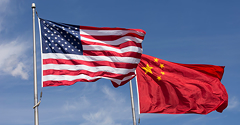US-China Truce on Trade War Is Good Progress
25/05/2018 03:32

Over the weekend, Treasury Secretary Steven Mnuchin, who led U.S.-China trade negotiations, announced a trade war between the two countries was “on hold.”
This progress will surely bring a sigh of relief for American farmers—and short-term stability to international markets as tensions rightly de-escalate.
Working Backward
The two sides have been negotiating over bilateral trade concerns for some time now. The most significant progress was made after two days of talks in Washington last week.
While Commerce Secretary Wilbur Ross will be traveling to China soon to flesh out the details of their agreement, for now the two sides have committed to:
• Suspend punitive tariffs. The U.S. will suspend its proposed tariffs on $150 billion worth of Chinese imports. The Chinese will suspend its proposed retaliatory tariffs on $50 billion in U.S. imports.
• Buy more American. China will commit to increasing its purchases of American energy—specifically, shale oil and liquefied natural gas—and purchase 35 percent to 40 percent more agricultural products in 2018. China’s Ministry of Commerce has also dropped its anti-dumping investigation on U.S. sorghum.
• Seek favorable conditions. The two sides will continue discussing ways to expand the trade in other manufactured goods and services.
• Protect intellectual property. China will make relevant amendments to its laws, such as its patent law, to strengthen intellectual property protection.
• Work together and encourage investment. The two sides will strive to create and encourage a fair and level playing field for investment. They also will continue high-level engagement to resolve trade and economic concerns.
The devil will be in the details, however. One issue the U.S. and China often have disagreed about is the time frame in which these agreements will go into force. But it’s good to know $200 billion worth of bilateral trade is no longer at risk of coming under a 25 percent tax increase.
Previous Demands
All of this comes on the heels of President Donald Trump’s economic team visiting Beijing earlier this month. From what’s been released publicly, very little came of these negotiations.
We did learn, however, the most important part of any negotiation—namely, what each side wants from the other.
The U.S. side made clear it would like Beijing to:
• Reduce the U.S. trade deficit with China by $200 billion by the end of 2020.
• Remove tariff and nontariff barriers equal to at least the same level as those of the U.S.
• Commit to improving access for U.S. services and agricultural products.
• Quit subsidizing, and giving other forms of government support for, its industrial policies.
• Not retaliate against U.S. measures to restrict Chinese investment in sensitive U.S. technology sectors.
• Eliminate certain requirements for joint ventures.
• Remove barriers to investment found on the Chinese “Negative List” for investment.
• Eliminate policies and practices that require technology transfer.
• Ensure there will be no more government-enabled cybertheft of intellectual property.
• Enforce better intellectual property protection.
• Withdraw its request for consultation from the World Trade Organization over the U.S.’ proposed enforcement of Title 3 of the U.S. Trade Act of 1974.
• Agree to meet quarterly to review the progress of reforms.
Beijing wants the U.S. to:
• Suspend the proposed 25 percent tariff on Chinese imports.
• Not initiate any investigations against China in the future.
• Drop the surrogate country approach in anti-dumping, anti-remedy cases.
• Open government procurement to Chinese technologies and services.
• Lift bans on the export of high technologies to China.
• Give equal treatment to Chinese companies in national security review.
• Open its e-payment market to Chinese companies.
• Approve China International Capital Corp.’s application for a financial license.
• Adjust the export ban for Chinese telecommunications company ZTE Corp.
It was unrealistic from the beginning to ask China to buy $100 billion more in American goods. The Chinese side took a hard stance against making outright purchases of any amount and pushed back against abandoning its industrial policy of Made in China 2025.
It was likewise unrealistic that the U.S. would open up purchases of U.S. sensitive technology to China—which is governed by American export control regulations—or give Chinese companies equal weight in government procurements. (China is not even a party to the World Trade Organization’s Government Procurement Agreement.)
Trump did ask the Commerce Department to look into re-evaluating its punishment of ZTE Corp. The company was essentially crippled in April after the Commerce Department announced U.S. companies must cease selling components to the telecom company.
The White House has been active in saying that the re-evaluation was separate from the ongoing economic negotiations and that ZTE will not be getting off “scot-free,” but U.S. intentions often differ from Chinese perceptions.
The administration is now considering changing the seven-year sanction to another round of fines and management changes.
A Freebee
Prior to the most recent negotiations, Chinese President Xi Jinping announced China would be making significant openings of its auto and financial sectors for foreign investment, as well as reducing tariffs on auto imports.
China has been making progress in reducing its barriers to trade and investment, but not specifically because of U.S. demands. Beijing’s announcement of its intention to reduce its tariffs on some auto parts from 25 percent to 15 percent will benefit all exporters to China, not just the U.S.
That said, negotiations over economic relations between the U.S. and China are far from over.
Tensions will likely heat up again at some point, especially as Washington goes into campaign mode, but the current solutions on the table are better than a trade war. Recognizing that is important progress for the administration.
This progress will surely bring a sigh of relief for American farmers—and short-term stability to international markets as tensions rightly de-escalate.
Working Backward
The two sides have been negotiating over bilateral trade concerns for some time now. The most significant progress was made after two days of talks in Washington last week.
While Commerce Secretary Wilbur Ross will be traveling to China soon to flesh out the details of their agreement, for now the two sides have committed to:
• Suspend punitive tariffs. The U.S. will suspend its proposed tariffs on $150 billion worth of Chinese imports. The Chinese will suspend its proposed retaliatory tariffs on $50 billion in U.S. imports.
• Buy more American. China will commit to increasing its purchases of American energy—specifically, shale oil and liquefied natural gas—and purchase 35 percent to 40 percent more agricultural products in 2018. China’s Ministry of Commerce has also dropped its anti-dumping investigation on U.S. sorghum.
• Seek favorable conditions. The two sides will continue discussing ways to expand the trade in other manufactured goods and services.
• Protect intellectual property. China will make relevant amendments to its laws, such as its patent law, to strengthen intellectual property protection.
• Work together and encourage investment. The two sides will strive to create and encourage a fair and level playing field for investment. They also will continue high-level engagement to resolve trade and economic concerns.
The devil will be in the details, however. One issue the U.S. and China often have disagreed about is the time frame in which these agreements will go into force. But it’s good to know $200 billion worth of bilateral trade is no longer at risk of coming under a 25 percent tax increase.
Previous Demands
All of this comes on the heels of President Donald Trump’s economic team visiting Beijing earlier this month. From what’s been released publicly, very little came of these negotiations.
We did learn, however, the most important part of any negotiation—namely, what each side wants from the other.
The U.S. side made clear it would like Beijing to:
• Reduce the U.S. trade deficit with China by $200 billion by the end of 2020.
• Remove tariff and nontariff barriers equal to at least the same level as those of the U.S.
• Commit to improving access for U.S. services and agricultural products.
• Quit subsidizing, and giving other forms of government support for, its industrial policies.
• Not retaliate against U.S. measures to restrict Chinese investment in sensitive U.S. technology sectors.
• Eliminate certain requirements for joint ventures.
• Remove barriers to investment found on the Chinese “Negative List” for investment.
• Eliminate policies and practices that require technology transfer.
• Ensure there will be no more government-enabled cybertheft of intellectual property.
• Enforce better intellectual property protection.
• Withdraw its request for consultation from the World Trade Organization over the U.S.’ proposed enforcement of Title 3 of the U.S. Trade Act of 1974.
• Agree to meet quarterly to review the progress of reforms.
Beijing wants the U.S. to:
• Suspend the proposed 25 percent tariff on Chinese imports.
• Not initiate any investigations against China in the future.
• Drop the surrogate country approach in anti-dumping, anti-remedy cases.
• Open government procurement to Chinese technologies and services.
• Lift bans on the export of high technologies to China.
• Give equal treatment to Chinese companies in national security review.
• Open its e-payment market to Chinese companies.
• Approve China International Capital Corp.’s application for a financial license.
• Adjust the export ban for Chinese telecommunications company ZTE Corp.
It was unrealistic from the beginning to ask China to buy $100 billion more in American goods. The Chinese side took a hard stance against making outright purchases of any amount and pushed back against abandoning its industrial policy of Made in China 2025.
It was likewise unrealistic that the U.S. would open up purchases of U.S. sensitive technology to China—which is governed by American export control regulations—or give Chinese companies equal weight in government procurements. (China is not even a party to the World Trade Organization’s Government Procurement Agreement.)
Trump did ask the Commerce Department to look into re-evaluating its punishment of ZTE Corp. The company was essentially crippled in April after the Commerce Department announced U.S. companies must cease selling components to the telecom company.
The White House has been active in saying that the re-evaluation was separate from the ongoing economic negotiations and that ZTE will not be getting off “scot-free,” but U.S. intentions often differ from Chinese perceptions.
The administration is now considering changing the seven-year sanction to another round of fines and management changes.
A Freebee
Prior to the most recent negotiations, Chinese President Xi Jinping announced China would be making significant openings of its auto and financial sectors for foreign investment, as well as reducing tariffs on auto imports.
China has been making progress in reducing its barriers to trade and investment, but not specifically because of U.S. demands. Beijing’s announcement of its intention to reduce its tariffs on some auto parts from 25 percent to 15 percent will benefit all exporters to China, not just the U.S.
That said, negotiations over economic relations between the U.S. and China are far from over.
Tensions will likely heat up again at some point, especially as Washington goes into campaign mode, but the current solutions on the table are better than a trade war. Recognizing that is important progress for the administration.
Source: The Daily Signal
Các tin khác
- Shrimp exports to major markets bounce back (22/04/2024)
- Vietnam becomes biggest rice supplier for Singapore (22/04/2024)
- Vietnam proposes removal of quota on shrimp export to RoK (22/04/2024)
- Early warnings reduce risks in trade defense (22/04/2024)
- Rubber exports are flourishing, promising potential (22/04/2024)
 Home
Home
 About Us
About Us




















